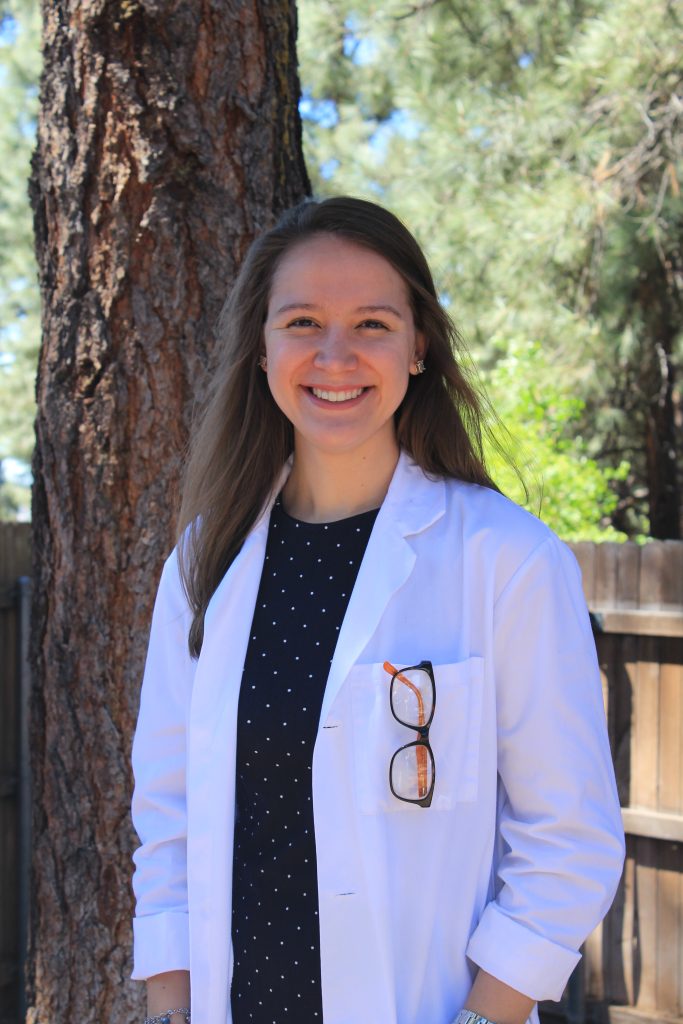Graduate students Maria Bolar and Megan Foley are the first from Northern Arizona University to receive awards from the U.S. Department of Energy’s (DOE) Office of Science Graduate Student Research (SCGSR) program. Only 65 graduate students from throughout the country were recognized this year. Through world-class training and access to state-of-the-art facilities and resources at DOE national laboratories, the program prepares graduate students to enter jobs of critical importance to the department’s mission and secures the nation’s position at the forefront of discovery and innovation.
The goal of SCGSR is to prepare graduate students for STEM careers critically important to the Office of Science’s mission by providing research opportunities through extended residency at DOE national laboratories. The program provides funding for the students to spend three to 12 months onsite at a DOE national laboratory conducting graduate thesis research in a priority research area, in collaboration with a DOE scientist. The projects they work on are expected to advance each student’s doctoral thesis while providing access to the expertise, resources and capabilities available at the DOE labs.
“The DOE Office of Science provides the scientific foundation for solutions to some of our nation’s most complex challenges, and now more than ever we need to invest in a diverse, talented pipeline of scientists, engineers and entrepreneurs who can help us build a brighter future,” said Harriet Kung, deputy director for science programs in the Office of Science. “These outstanding students will help us tackle mission-critical research at our labs as this experience helps them begin a successful and rewarding career.”
Bolar to study fundamental electrochemistry for chemical and materials sciences at Oak Ridge National

Laboratory
Working on her Ph.D. in applied physics and materials science (APMS), Bolar has been performing research with NAU professor Cindy Browder and her lab group in the Department of Chemistry and Biochemistry, investigating the physical properties of polymer electrolytes for use in energy storage devices such as supercapacitors. “Using organic chemistry, we have the ability to tune these electrolytes, and we have synthesized a variety of different polymer precursors using several different polymerization methods,” Bolar said. “As we modify these molecules, it is important to keep in mind how these changes affect the dynamics of the polymers and the movements of the ions.”
Bolar’s DOE award of $12,000 will enable her to work with senior staff scientist Gabriel Veith at Oak Ridge National Laboratory (ORNL) in Tennessee for four months.
At ORNL, she will use quasi-elastic neutron scattering, among other neutron-based techniques, to fully characterize these different molecular mechanisms. NAU offers access to a range of electron microscopy instruments; however, Bolar said these instruments fail to distinguish smaller atoms that comprise the majority of electrolytes, which is what her team is most interested in understanding. The explanations of the polymer dynamics and ion diffusion will help explain the exciting thermal, electrochemical and mechanical trends they observe now as they modify the structure of the polymer electrolytes.
“I am tremendously excited for this amazing opportunity,” Bolar said. “I am not sure what I am looking forward to more—the fast-paced environment of a national lab, or finally having a molecular understanding of the polymers I have been working with for the past several years. I am proud to be representing the school that serves as both my alma mater and current graduate institution, as well as the rising Applied Physics and Material Science community within NAU.
Faculty who helped mentor Bolar include Gabriel Montaño, Jennifer Martinez, Gerrick Lindberg, Constantin Ciocanel and Browder, who is the principal investigator on the project Bolar has worked on.
“I am very lucky to have such a capable team of professionals that are constantly supporting me and challenging me to be the best growing scientist I can be.”
Said Browder, “It has been a pleasure and an honor to work with Maria in her journey from undergraduate researcher to chemistry MS student and now as an APMS Ph.D. candidate. My lab has benefitted tremendously from Maria’s skills and leadership over the years. Maria has always been resourceful, but she has gone above and beyond by gaining the ability to use neutron scattering techniques to examine our electrolytes at the atomic level. Maria’s award project will benefit the group for years to come, and I couldn’t be prouder of her accomplishment.”
Foley to study environmental microbiology at Lawrence Livermore National Laboratory

Working on her Ph.D. in Biological Sciences, Foley has been studying with Regents’ professor Bruce Hungate in the Center for Ecosystem Science and Society, exploring research questions central to her dissertation, such as “How does life and death in the soil microbiome drive elemental transformations and contribute to key ecosystem processes?” and “How will all of this be impacted by climate change?”
Foley’s DOE award of $18,000 will enable her to work with senior staff scientist Jennifer Pett-Ridge at Lawrence Livermore National Laboratory (LLNL) in California for six months. Her work will be a component of Pett-Ridge’s research, which looks at how the traits of microorganisms during their life and the composition of their necromass after death matter for how long carbon is sequestered in soils.
“Soils are earth’s largest terrestrial pool of organic carbon, so these research questions are driven by their relevance to carbon cycling and climate change. My project will use metatranscriptomics to analyze how microbial expression of genes involved in carbohydrate depolymerization changes with drought,” Foley said. “Overall, we want to understand how changing soil water dynamics, emergent properties of complex soil habitats and microbial trait expression interact to drive carbon transformations.”
“I’m really looking forward to my time at LLNL. Dr. Pett-Ridge has been integral to all of my dissertation work, something that my Ph.D. advisor, Dr. Hungate, has facilitated and encouraged. The two have been collaborating for years and together bring a creative and quantitative angle to these research questions that really resonate with me and are central to my dissertation, and there’s tremendous synergy between the work being done at NAU and LLNL that is steeped in omics approaches, stable isotope probing and other cutting-edge techniques in quantitative microbial ecology—the heart of which lies in ecosystem ecology. I’m excited to be immersed in the work that the LLNL team is doing and to see how this research gets done at a large DOE-funded national lab.”
Said Hungate, “Megan is amazing. Along with her cutting-edge research, she’s teaching a course on intersectionality in science, bringing the national conversations about equity and access to the science classroom. She’s about to teach another one, too, all about extreme microbes. All of this on top of her research, which is pushing the field of microbial ecology forward. She’s a multi-talented rising star, and I’m so proud of her.”
Kerry Bennett | Office of the Vice President for Research




